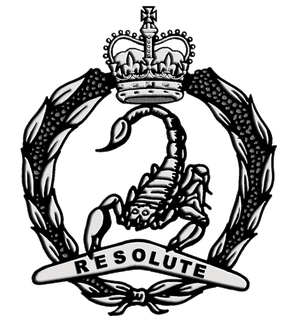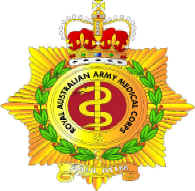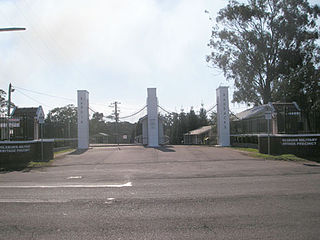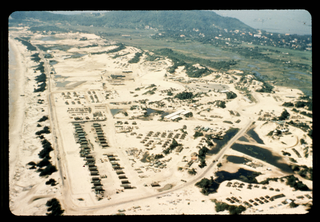The military history of Australia spans the nation's 230-year modern history, from the early Australian frontier wars between Aboriginals and Europeans to the ongoing conflicts in Iraq and Afghanistan in the early 21st century. Although this history is short when compared to that of many other nations, Australia has been involved in numerous conflicts and wars, and war and military service have been significant influences on Australian society and national identity, including the Anzac spirit. The relationship between war and Australian society has also been shaped by the enduring themes of Australian strategic culture and the unique security challenges it faces.

The 3rd/4th Cavalry Regiment is an armoured unit within the Australian Army's Royal Australian Armoured Corps. Formed in 1981 with the amalgamation of the 3rd Cavalry Regiment and the 4th Cavalry Regiment, from 1986 to 2014 the unit consisted of an independent squadron, B Squadron 3rd/4th Cavalry Regiment, within the 3rd Brigade in Townsville, Queensland. From 2017, B Squadron 3rd/4th Cavalry Regiment has been the training support and logistics squadron within the School of Armour at Puckapunyal in Victoria.

The Royal Australian Army Medical Corps (RAAMC) is the branch of the Australian Army responsible for providing medical care to Army personnel. The AAMC was formed in 1902 through the amalgamation of medical units of the various Australian colonies and was first deployed to South Africa as a small detachment of personnel supporting the Australian Commonwealth Horse during the Second Boer War. The corps has participated in every Australian Army operation since then, including wars and peacekeeping operations. The "Royal" prefix was granted in 1948.

The 1st Australian Task Force was a brigade-sized formation which commanded Australian and New Zealand Army units deployed to South Vietnam between 1966 and 1972. 1 ATF was based in a rubber plantation at Nui Dat, 8 kilometres (5.0 mi) north of Bà Rịa in Phuoc Tuy Province and consisted of two and later three infantry battalions, with armour, aviation, engineers and artillery support. While the task force was primarily responsible for securing Phuoc Tuy Province, its units, and the Task Force Headquarters itself, occasionally deployed outside its Tactical Area of Responsibility.

Australia was a member of the international coalition which contributed military forces to the 1991 Gulf War, also known as Operation Desert Storm. More than 1,800 Australian Defence Force (ADF) personnel were deployed to the Persian Gulf from August 1990 to September 1991, while contingents from the Royal Australian Navy circulated through the region in support of the sanctions against Iraq until November 2001. In August 1990, two frigates HMAS Adelaide and HMAS Darwin and the replenishment ship HMAS Success left for the Persian Gulf. HMAS Success had no air defences, so the Army 16th Air Defence Regiment was embarked. On 3 December 1990, HMAS Brisbane and HMAS Sydney (IV) relieved HMAS Adelaide and HMAS Darwin. On 26 January 1991, HMAS Westralia replaced HMAS Success. A Navy clearance diving team was also deployed for explosive ordnance disposal and demolition tasks. Australian ships were in danger of sea mines and possible air attacks. In a number of recorded incidents, HMAS Brisbane encountered free floating mines, on one occasion narrowly avoiding a collision. Both HMA Ships Brisbane and Sydney encountered significant air threat warnings from Iran and Iraq throughout the initial period of the commencement of the Desert Storm Campaign. The detection of land based Silkworm anti-ship missiles from Iran throughout the campaign also added to the challenges for both crews as well as the multi-national Naval Forces.

New Zealand's involvement in the Vietnam War was highly controversial, sparking widespread protest at home from anti-Vietnam War movements modelled on their American counterparts. This conflict was also the first in which New Zealand did not fight alongside the United Kingdom, instead following the loyalties of the ANZUS Treaty.
The Unit Citation for Gallantry is a collective group decoration awarded to members of Australian military units. It recognises extraordinary gallantry in action. The Unit Citation for Gallantry was created in 1991, along with the Meritorious Unit Citation. The actual citation is a warrant presented to the unit. Insignia are worn by individuals to denote their membership of a unit that has been awarded a citation. Personnel cannot be issued with the insignia until the authorised unit representative, normally the Commanding Officer, has been formally invested with the citation.

The 2/12th Field Ambulance was an Australian military unit of the Second Australian Imperial Force, serving during World War II. During their six years of service, over 200 soldiers were killed, the highest figure for a non-combatant unit in Australian history. The majority of the unit's casualties were suffered during the sinking of the hospital ship Centaur in May 1943. During the war, the 2/12th deployed personnel in support of Australian combat operations against the Japanese on Ambon, Timor and in Borneo before being disbanded in 1946.

Ingleburn Army Camp was a purpose-built camp constructed in 1940 for the Australian Army at Ingleburn, New South Wales, Australia.
The 1991 uprisings in Iraq were a series of anti-governmental intifada (rebellions) in Southern and Northern Iraq during the aftermath of the Gulf War in March–April 1991. On 16 May 1991, 75 Australian Defence Force (ADF) personnel were deployed to Kurdistan, northern Iraq on Operation Habitat, Australia's contribution to the multinational response known as Operation Provide Comfort.

This article incorporates public domain material from websites or documents of the United States Army.

The Royal Australian Army Dental Corps (RAADC) is a corps within the Australian Army. It was formed on 23 April 1943 during World War II as the Australian Army Dental Corps, before being granted the 'Royal' prefix in 1948. Prior to its formation dentists were part of the Australian Army Medical Corps. The role of the RAADC is to provide dental care to army personnel in order to minimise the requirement for the evacuation of dental casualties, to conserve manpower and to reduce the burden of casualty evacuation. In the post-war years, the corps has provided personnel to deployments in Japan, Korea and Vietnam. It has also contributed to peace-keeping operations in Somalia, Rwanda, Bougainville and East Timor.
The 1st Australian Logistic Support Group was a ground support unit of the Australian Army during the Vietnam War located at the 1st Australian Support Compound in Vũng Tàu. 1 ALSG commanded logistic support units to all Australian forces in South Vietnam and was composed of engineer, transport, ordnance, medical and service corps units. The unit was initially formed in 1965 as the Australian Logistic Support Company to support the 1st Battalion, Royal Australian Regiment, and was redesignated as 1 ALSG in April 1966 following the deployment of the 1st Australian Task Force as the Australian commitment in Vietnam expanded.

The 8th Field Ambulance was a medical unit of the Australian Army. It was originally formed for service during World War I as part of the Australian Imperial Force, and served mainly on the Western Front between 1916 and 1918, before disbanding in early 1919. During World War II, the unit was re-raised as a Militia unit and served in Western Australia, New Guinea and Bougainville. During the Vietnam War, the unit served in Vung Tau in support of the 1st Australian Task Force between 1967 and 1968, before being disbanded in 1972. The unit's designation is now perpetuated by one for the 1st Close Health Battalion's close health companies.

The order of battle of Australian forces during the Vietnam War consisted of a small group of military advisors from 1962, but grew to include an infantry battalion based in Bien Hoa in 1965. This force was then replaced by a two- and later three-battalion task force with supporting arms based at Nui Dat which operated primarily in Phuoc Tuy Province between 1966–71, with logistic elements at Vung Tau. Airforce units committed initially consisted of transport aircraft, but were followed by helicopters and later bombers, while naval forces included destroyers and transport vessels. With the size of Australian forces in Vietnam reaching a peak in early 1968, a drawdown commenced in late 1970, with the bulk withdrawn by early 1972. The last elements returned to Australia in 1973. In total, around 50,000 Australians served during the Vietnam War, including 42,437 members of the Australian Army, 3,310 from the Royal Australian Navy (RAN), and 4,443 from the Royal Australian Air Force (RAAF), with casualties including 519 killed and 2,348 wounded.

The logistical support of the multinational International Force East Timor (INTERFET) peacekeeping mission in 1999 and 2000 involved, at its peak, 11,693 personnel from 23 countries. Of these 5,697 were from Australia, making it the largest deployment of Australian forces overseas since the Vietnam War. INTERFET was unusual in that it was led by Australia, casting the country in a wholly unfamiliar role. The logistics and support areas of the Australian Defence Force (ADF) had been subject to deep cuts in the 1990s. The ADF had not anticipated being committed to such a large peacekeeping mission, and was unprepared to support an Australian force projection of this size, much less act as lead nation of an international coalition.

Operation Hardihood was a security operation conducted from 16 May to 8 June 1966 during the Vietnam War by the U.S. 503rd Infantry Regiment, the 1st Battalion, Royal Australian Regiment (1RAR) and the 5th Battalion, Royal Australian Regiment in Phước Tuy Province, South Vietnam to secure the area around Nui Dat for the establishment of a base area for the 1st Australian Task Force.

The 68th Medical Group was constituted on 18 October 1927 in the Regular Army as the 18th Medical Regiment. Redesignated as the 68th Medical Regiment and reorganized as the 68th Medical Group, the organization served in combat in Europe in World War II and in the Republic of Vietnam. During the Cold War, it was stationed at Fort George G. Meade, Maryland from 1954 until its deployment to Vietnam and was reactivated again in Germany, where it served from 1978 into the 1990s.

1st Australian Support Compound was a complex of logistics and support bases operated by the 1st Australian Logistic Support Group in Vũng Tàu, Phước Tuy Province, South Vietnam during the Vietnam War.

Vung Tau Air Base (1955–1975) was a Republic of Vietnam Air Force (RVNAF) facility. It was located near the city of Vũng Tàu in southern Vietnam. The United States used it as a base during the Vietnam War (1959–1975), stationing Army, Air Force and Navy units there. It was also the main base supporting Australian operations in the war and Australian Army and Royal Australian Air Force units were based there. Following the Fall of Saigon it reverted to a civil airport which remains in use today.



















